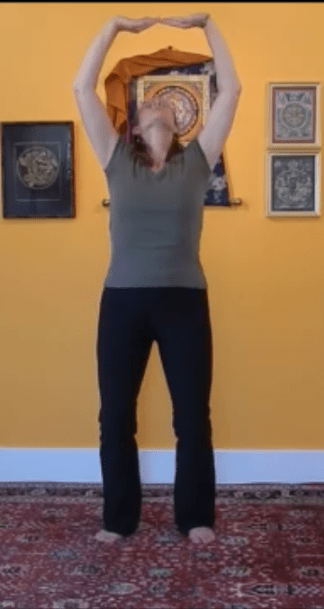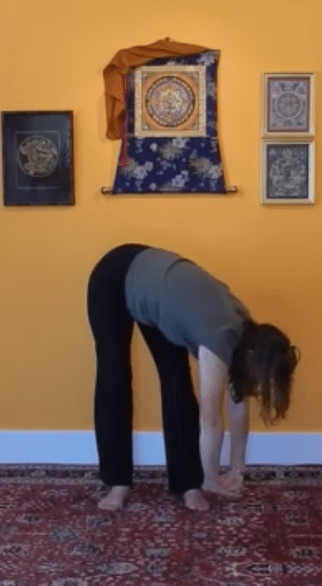What is the Healing Power of Qigong, and How Can It Help Your Body and Mind?
Qigong is an ancient practice that helps you deepen your body-mind connection. This post explores the healing power of qigong and helps you unlock your innate wellness and connect to youthful vitality.
Pronounced “chee gung,” this movement-based form of traditional Chinese medicine was developed thousands of years ago. This ancient Chinese healing practice embodies physical and psychological elements. It strengthens and balances your body and mind by harmonizing your mind, body, emotions, and spirit.
Life often presents uncertainties and challenges. While we often don’t have control over circumstances outside ourselves, qigong offers a powerful method for transforming and releasing physical, emotional, and mental stress and cultivating a calm sense of inner peace.
In English, qigong is often considered to mean “energy work.” In Chinese, qigong represents “chi” or “ki” or “qi” cultivation, which refers to the concept of harnessing the life-force energy called chi or ki to promote health.
Qigong is a relative of tai chi. Tai chi began as an ancient martial art that often follows specific forms.
When tai chi is practiced for general health, it is considered a form of qigong as it involves flowing physical movements, controlled breathing, and focused attention.
Qigong, a potent meditative healing practice, focuses less on form and combines slow, gentle movements, present-moment awareness, and breathing exercises to promote relaxation, reduce stress, and enhance physical and mental well-being.
Most qigong forms include the following:
- Long, low, full, deep breaths that vary from relaxed diaphragmatic breathing—also known as abdominal breathing or belly breathing—to breathing patterns that activate your internal energy or qi.
- Gentle and smooth, flowing movements designed to mobilize tendons, joints, circulation of blood and oxygen, and qi.
- Attention regulation which encourages you to remain in the present moment and focus your thoughts on peace, tranquility, and ease.
- Intentional activation of the body’s energy system, qi, which helps improve physical health and mental clarity.
The Healing Power of Qigong for Mental Health and Stress Relief
In today’s world, we live with information overload, which often leads to overwhelm. If we want to lose weight, become fit, and enhance our health, we are bombarded with multiple messages about how to do all that. Sometimes perceived complexity prevents us from starting or sticking with any type of wellness program. Qigong can be an antidote.
Qigong helps boost energy levels, improve focus, and reduce pain, but it is also instrumental in improving mood and enhancing relaxation. Studies have shown that regular practice reduces depression, anxiety, and stress.
In a study on traditional Chinese practices for depression in older adults, the researchers found that qigong was associated with reduced depressive symptoms compared to other forms of exercise, such as tai chi or walking. Another study showed that when participants practiced qigong versus walking for ten days, they had an overall decrease in perceived stress levels and an increase in self-reported feelings.
Qigong works best when you implement a simple and consistent practice. Choose a routine or combine some of your favorite qigong movements and practice daily. Try these two simple practices below to calm your mind and relieve stress and anxiety. Use them in the morning just after getting out of bed and again in the evening before getting into bed.
Wave Breathing:
Stand with your feet about shoulder-width apart, or sit at the very front edge of a chair. Imagine your tailbone reaching to the earth and the crown of your head reaching to the sky. Put a gentle, easy smile on your face and relax your jaw. Place one hand on your chest and the other on your belly. It doesn’t matter which hand goes where; place them however it feels natural to you.
Start to inhale slowly, deeply, and fully. Feel your lower abdomen expand, then feel your chest start to expand. When you exhale, release the air from your lungs and let your chest contract gently, then let your belly contract gently. Do your best to make each breath long and full. Noticing the rise and fall of your hands on your belly and chest helps you connect with the notion of breathing into your belly before your chest.
In qigong, the breath provides an essential communication path between the body, mind, and emotions. Working intentionally with the breath helps you connect with your emotional state and reminds you to release the stress and anxiety that doesn’t serve you.
Supporting the Sky:
After a couple of minutes of abdominal wave breathing, add some simple arm movements. If you find it helpful, you can repeat a word such as “peaceful, calm, tranquil.” Or use any other word or phrase that helps you connect more deeply to this state of present-moment relaxation.
Standing or sitting as you were before, on your next inhale, draw your hands, palms up, fingertips toward each other, up past the middle of the body.
At the level of your upper chest or chin, wherever is comfortable for you, rotate your palms down, out, and up again and continue upward movements with palms to the sky until your arms are fully extended above your head at the top of your inhale.
As you exhale, allow your hands to float slowly downward at your sides, palms down toward the earth. As your arms float downward, bend your knees slightly.
Let your hands hang gently by your hips for a moment. Then at the next inhale, begin the cycle again, straightening the knees and lifting the hands to the sky.
Complete this cycle for a couple of minutes or a few repetitions. As you bring it to a close, notice your thoughts and emotions. Are you feeling more peaceful and less anxious or stressed?
The Healing Power of Qigong for Physical Ailments
Qigong has an amazing ability to activate the body’s internal healing potential. Whether you struggle with back pain, headaches, digestive issues, or other ailments, you’ll often find qigong movements that can help you. Qigong may also reduce pain by stimulating the body’s natural healing by activating your qi.
This type of healing balances the body’s energy flow which can help reduce inflammation and alleviate pain. Additionally, qigong helps strengthen the immune system by increasing blood, lymph, and oxygen circulation, which may help thwart disease.
It is a low-impact activity that often boosts energy levels, activates mental focus, and may provide pain relief. This ancient Chinese practice combines physical postures with flowing movement, breathing exercises, and meditation or mindfulness. You may find you’ll have better balance, healthier posture, increased strength and flexibility, and improved cardiovascular health.
It can help you improve your circulation, strengthen your muscles, increase your flexibility, reduce pain, improve your sleep, boost your mood, reduce stress, increase your energy levels, and improve your overall sense of well-being.
Through qi energy healing, one can even find relief from chronic pain conditions such as arthritis or fibromyalgia. Many qigong movements focus on infusing soft tissue—including ligaments, tendons, and fascia—with qi. With consistent practice, the body becomes significantly stronger and more flexible.
Qigong, through transforming energetic states, also helps us release pain by addressing the true origin of our discomfort. Many people report significant pain reduction after only a few days of regularly practicing simple qigong movements.
It also helps you activate your body’s parasympathetic nervous—the “rest and digest” side of the nervous system—which allows you to direct your energy, qi, towards boosting your immune system, which is a key component of healing.
Wagging the Tail
This movement works best with a standing posture and can be added right after a few cycles of Supporting the Sky.
Stand with your feet about shoulder-width apart. Imagine your tailbone reaching to the earth and the crown of your head reaching to the sky. Put a gentle, easy smile on your face and relax your jaw.
Draw your hands together near the lower abdomen, interlacing the fingers. Just as the start of Supporting the Sky, draw your hands upward with the palms turned up on an inhale.
Pause at the upper chest and rotate your palms so they face outward, away from you. Stretch your arms forward while your fingers are still interlocked, and extend your elbows fully.
As you exhale, bend forward from the waist with a straight back and straight legs. Drop your palms down toward the floor, letting your head hang. Go only as far as is comfortable, and do not force your movement.
Keep your knees straight. Your palms may not touch the floor, and that is okay. Notice the gentle stretch on the back of the legs.
Inhale and draw the arms and palms upward, letting your spine straighten vertebrae by vertebrae as you come up. Continue your arm and palm movement upward until you reach your upper chest.
Again rotate your palms outward and bend from the waist with a flat back. Do this movement one more time for a total of three times.
After the third forward bend, as you come upright, twist from the waist to the left. Once again, extend your palms outward, then on the exhale, bend at the waist and spiral your way back to the center. You’ll feel a gentle stretch along your right side and then the back of the legs as you do this movement. Follow this pattern to the left two more times for a total of three.
Then rotate from the waist to the right, and follow the same movement pattern three times to the right. Finally, follow this movement three more times along the center line, repeating the first three moves of this sequence. At the end of the sequence, let your hands hang gently by the hips and notice what you feel in your body.
It’s truly profound how transformative qigong can be when overcoming injury or illness. That said, though qigong is a wonderful tool to help you work with many physical challenges, it’s also important to also consult with medical professionals as necessary.
Monday Morning Qi Gong Classes
If you’d like to experience some of the wonderful benefits you’ve just read about, join us for a weekly 45-minute online qigong class on Monday mornings from 7:00 am to 7:45 am Pacific Time via Zoom. Wear loose, comfortable clothing, and be prepared to stand, move, and sit.
The class consists of 3 components:
- Gentle flowing warm-up exercises
- One of a variety of standing movement forms, this changes every few months
- A seated mudra series I developed to cultivate compassion
While it’s not physically face-to-face in the same room, participants interact online in real-time from their homes.
The benefits of qigong are limitless. Learn how to be present in your body and with your mind and emotions while cultivating a sense of peace and relaxation. Open the door to the growth that a qigong practice offers. Click on the banner below to learn more and sign up today.
Learn more about qigong and the benefits of this practice in these articles.
Deep Breathing & Qigong Reduce Anxiety: An informative article on how to use qigong and breathing as an effective stress reduction too; this article includes two easy-to-implement qigong and breathing exercises.
Embodied Mindfulness Harmonizes Mind & Body: Qigong is an example of an embodied mindfulness practice. It is shown to reduce stress, anxiety, and depression; this article also includes an easy-to-implement qigong exercise.
For further support, as you start or deepen your qigong practice register for the Monday morning online qigong classes.
To enhance your qigong and meditation practices enroll in an upcoming BodyMind IntelliSense or Compassion Cultivation Training program, or join me for an International Spiritual Tour where we’ll time daily practicing compassion meditation, qigong, and tools to create a positive mindset while exploring beautiful landscapes and fascinating cultures.











